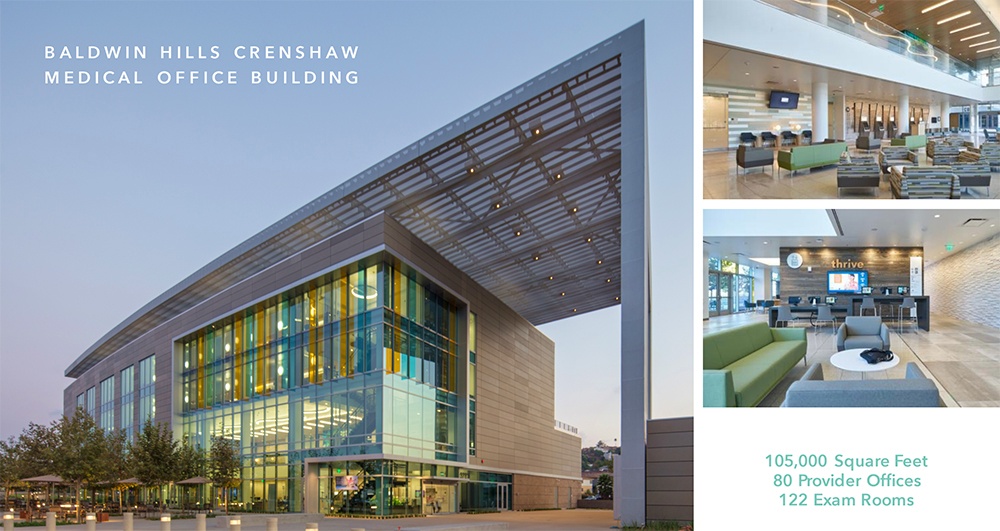Social and economic determinants have an undeniably profound influence on health. In Los Angeles, traveling just five miles can reduce a person’s life expectancy by 10 years.
Kaiser Permanente could no longer ignore statistics like these, and recognized a tremendous opportunity to bring “health beyond the hospital,” an approach that they refer to as “Total Health.” A tall order, indeed, but one that’s already proved incredibly impactful in Crenshaw, a historically neglected, crime-ridden south L.A. neighborhood.
At HealthSpaces, Jodie Lesh, SVP, Office of Transformation, discussed Kaiser’s journey to build a care system centered around the concept of total health. She also discussed the 2017 opening of the state-of-the-art Baldwin Hills-Crenshaw Medical Office Building, which has been successful in sparking local economic opportunities and bringing quality healthcare services to an area where they were previously inaccessible.
Addressing the Social Determinants of Health
There are many elements that make up the fabric of our health: economic factors like education, employment, income, and social support, the air and water quality of our physical environments, health behaviors like diet and exercise, and access to clinical care. And of course, the quality of that clinical care.
Determined to directly address the social determinants of health, Kaiser reevaluated their mission statement so that it now reads: “Kaiser Permanente exists to provide high-quality, affordable healthcare and to improve the health of our members and the communities we serve.”
There was a need to relieve pressure off the West L.A. Main Medical Center, and the team recognized an opportunity to put the mission of “total health” into action. By opening the new location in an underprivileged community, the hope was to spark revitalization in a place where it was desperately needed.
Lesh was stunned by the disparity she saw when closely analyzing the south L.A. market. There were two communities, with a similar amount of members, yet the more affluent one had 11 MOB’s and one hospital, while the Baldwin Hills area (which had a 30% poverty rate) had just 2 MOB’s and zero hospitals. Lesh’s team realized that they hadn’t been intentional about showing up for this underserved community...and it was time to make a change. They spent months conducting intensive field research to find out what this population wanted and needed.
“We realized how many complications this population faced. They needed jobs and a safe place to go in the community. Almost 50% were unemployed, and the people in this area had experienced so many failed development promises,” she said.
Creating Shared Value
Once the Kaiser team found a 22-acre property, they began the process of intentional, impactful facility planning. Lesh emphasized the importance of creating shared value between KP’s business needs and the community needs...
Business needs:
- Primary care off hospital campus to expand specialty care
- Improved geographic access
- Focus on total health and wellness
- Health equity
- Affordable real estate of sufficient size in urban LA
Community needs:
- Access to quality care
- Health equity
- Safe community gathering spaces
- Employment opportunities
- Economic revitalization
- Environmental clean-up
- Respect for the uniqueness of the community
The cutting-edge four-story facility officially opened in September 2017, and now offers a full range of primary care and specialty care services. Kaiser cultivated shared value in a variety of ways, from decorating the building with original art by residents to providing a safe space with Wi-fi.
They developed 2.5 acres of green space, which includes outdoor exercise equipment and health-related classes for the entire community. 30% of the employees were locally hired and 50% of contracts went to diverse teams (ones owned by minorities and women). Kaiser also went out on a limb and did something totally new by welcoming formerly incarcerated individuals to the labor crew and providing them full benefits and living wages.
The energy-efficient smart building was also certified LEED Gold and includes advanced medical technology, from virtual streaming in exam rooms to self-check-ins for patients.
An Ongoing Impact

In just over a year, the Baldwin Hills-Crenshaw MOB has already spurred further economic development, with the recent announcement that a Coffee Bean and Tea Leaf will open nearby.
It’s also made a huge impact on a personal note for countless individuals, like Charles Slade. At age 21, Slade was convicted for gang-related murder and served 28 years in prison. When he was released, he was struggling to create a fresh start as most of his peers were planning for retirement. “Now, he’s rebuilding the very community he tore down, and he just bought his first house,” Lesh shared.
The Baldwin Hills-Crenshaw facility is a powerful example of how health systems can truly extend their reach into other spheres of people’s lives and build stronger communities.
“We built a beautiful facility, but it's not just a building. There's so much life in this building. We can get our business done, but have a much greater impact than we ever imagined.”

Posted by
Collaborate with your Peers!
HealthSpaces is a community for people that plan, design, build and operate spaces where healthcare is delivered.
June 7-9, 2026 | Braselton, GA
Learn More




-4.png)
-Dec-09-2025-05-48-44-4379-PM.png)
-4.png)
-1.png)
-2.png)

Comments